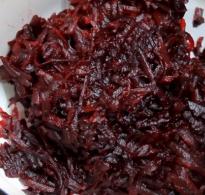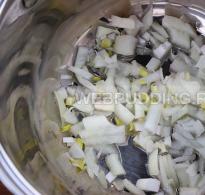Myths and reality about GMO products. How to distinguish GMO products? Genetically modified organisms and products (GMOs)
As a prologue: Genetic engineering is the work of an alchemist - mix everything and look at the result, but only the result of this alchemy can become a monster.
I have long wanted to write an article about what GMOs are and whether they bring harm or benefit. Today there is a lot of talk about the terrible GMOs, but all this is at the level of talk and scarecrows. They show a lot on TV, but everything is also very unclear and unfounded. I decided to try to understand what it is, what impact GMOs have on humans and nature. There is very little information on the topic of GMOs on the Internet, mostly a few articles, but the information is minimal, and you can’t trust it, even the all-knowing Wikipedia gets by with a very meager article. In my search for complete and reliable information on this topic, I came across a collection of articles entitled “GMOs - hidden threat" So let's look at this problem together.
First. Let's start with a definition. Explanation GMO - genetically modified organism. GMI is a genetically modified source. A GMO is an organism in which the gene/genes of another organism have been artificially inserted into its genetic apparatus (genome).
All GM plants are divided into two categories. Some are resistant to herbicides (mostly Roundup), so that fields can be watered with these herbicides and protect the crop from pests. The second part is plants that contain Bt toxin, which makes the plant poisonous to pests.
Second. Why is all this needed? Everything is very simple here. In order to give a certain plant the necessary properties, many years of selection work are needed (selection of plants with a certain property, crossing with other varieties, but the result is difficult to achieve, it is often unpredictable). In the case of GMOs, when a certain gene is inserted, the plant acquires the desired properties - everything is simple and fast. In this way, varieties are instilled with resistance to certain pests, resistance to certain pesticides, increased yield, etc. All this simplifies agricultural technology, and therefore reduces the cost of production. On this side, the goal is noble - food becomes cheaper, you can feed the entire planet... But is this so?
Third. Spread of GM organisms. The main GMO crops that have undergone GM technologies are soybeans, potatoes, corn, rapeseed, grains, and rice. Through these crops, GM components reach food producers - in flour, chocolates, sausages, and all kinds of food additives, baby food etc.
A number of companies supply GM products to Russia and the volume of supplies is growing every year. If we talk about seeds and plant varieties, then in 2003 in Russia it was allowed to grow 9 GM varieties, in 2009 - already 15 varieties (soybeans, corn, potatoes, rice, sugar beets).
Fourth. The danger of GMOs. What could be the hidden problem here? Each organism has a very complex structure - tens of thousands of genes work (more than 50 thousand genes, of which 200-300 have been relatively studied). Each one is not only responsible for its own work, but all genes interact with each other. The inserted foreign gene works not only for itself, but also changes the work of other genes. To date, these processes have not been studied, and it is impossible to determine all the consequences. According to Omelchenko’s research, 1% of all mutations in GM organisms can be toxic. The technology for creating GMOs itself is dangerous. The gene is inserted into the host DNA chain by a vector bacterium. But it is impossible to determine in advance exactly in which area the foreign gene will be inserted, and whether unwanted debris (various bacteria) will be introduced.
Risks of spreading GMOs:
1. As I already wrote, GMOs are created to be resistant to certain pests (the Colorado potato beetle, for example). As a result of the cultivation of GM crops, pests and viruses mutate and become more aggressive and resistant even to GM crops, this leads to the emergence of races of super-pests! Therefore, the creation of such crops for the purpose of pest resistance does not justify itself! And pests can also move from conventional food to other traditional varieties and crops and put them at risk.
2. The effect of GMOs on human health has not been studied. But recent research has proven that the spread of allergies in children is the work of GM soybeans (by the way, the European Union has banned the use of GM raw materials in baby food for this reason)! There is also another danger - an embedded foreign gene can pass into the intestinal microflora. The result is the spread of new bacteria, and the intestines may become resistant to antibiotics! Plasmids (with the help of which the necessary genes are transferred) can themselves carry various information - from the pathogenicity of fungi to the sterility of plants. The use of crops with Bt toxin leads to crop toxicity not only for certain pests, but also for humans (many proteins are toxic to humans, but some have not even been studied).
3. The impact of the spread of GM crops on biodiversity is unknown. Stronger crops can push competitors out of natural ecosystems. But we know that diversity is the key to the sustainability of nature. Another danger is that GMOs may subsequently mutate or degenerate due to natural factors, and by this time the natural forms will already be destroyed. GM plants that contain Bt toxin kill not only pests, but when they get into the soil they destroy many other animals and protozoa!
4. Weeds that are not resistant to pesticides will eventually adapt and become insensitive, creating super weeds. Also, agricultural GM crops can cross-pollinate with wild weeds, which will generally lead to uncontrolled processes. Uncontrolled cross-pollination itself can cause the loss of old varieties or any wild species.
Summary: Use GMOs lead to harm to human health and destruction of the ecosystem - is it really worth it? ???
Fifth. What about in practice? Everything written above is a theory, but it is not just a theory. GM soybean with gene brazil nut, which is resistant to Roundup causes severe allergies in some people, the same applies to GM papaya. In the USA and Canada, already in 2005, populations of pests insensitive to GM plants were discovered. In Canada, populations of GM plants have been found that are resistant to herbicides, and in India, herbicide resistance has been transferred to wild mustard, which has become a virulent weed. Ladybugs that fed on aphids on GM potatoes became infertile. The situation with GM potatoes is bleak - the Colorado potato beetle dies from it, but during storage such potatoes rot: up to 70% of the harvest (potatoes go straight to processing), and so that the Colorado potato beetle does not get used to these varieties, they need to be changed every year! If we talk about the harvest, then the new varieties turn out to be very capricious, the influence of weather plays a big role and the yield changes by 60-80% (depending on the weather - harvest/failure, but the old traditional local varieties give an average harvest, but stable and independent from the weather).
I won’t continue about the harm of GMOs, but for today I have accumulated huge amount facts of the negative impact of GMOs on humans and nature.
Sixth. And who needs all this? On the one hand, there was an idea to make the production of valuable crops simple and cheap (due to resistance to pests and pesticides, increasing yields), but we clearly saw that this goal has not been achieved and this path is a dead end. If we look at the problem from the other side, then 94% of all GMOs are produced by the American company Monsanto (GMO manufacturers - Monsanto, Syngenta, Bayer Crop Saenz, Bioengineering RAS). In addition, they are trying to make GM varieties resistant to the herbicide Roundup. But Roundup is a product of the same Monsanto! GMOs are a huge business in the hands of an American corporation!
I would like to note one more important point. We talked about increasing crop yields. GMO technologies also make it possible to endow crops with other properties - so that the plant contains active substances - vaccines, growth hormones, antibodies, etc. medical point From a perspective, this is also justified - to reduce the cost of creating drugs. But there are corn and rice crops containing contraceptive proteins, immune suppressing cytokines and abortion-inducing substances! Those. the creation of such GMOs is a terrible weapon in the hands of American corporations! What will happen if such organisms leak into nature (and there have already been many such examples)?!
And one more conclusion. For Russia there are two options for the development of events. The first is that the spread of GMOs makes us dependent on American companies and jeopardizes national security and threatens the ecosystem throughout the country. The second option - abandoning GMOs and cultivating environmentally friendly products will provide us with food, independence, and importing products abroad will attract huge revenues (estimated at up to $100 billion!!!). Which path to choose is up to us to decide! Which way the scales will tip depends on you and me.
What to do. I decided to write this article to briefly and clearly outline the threat of harm to GMOs in Russia that hangs over us. But the goal is not to intimidate, no, the goal is to understand the problem. What to do?
1. In the store, reduce the number of products of unknown origin. No one knows what Snickers or sausage contains. Natural products will reduce the risk of GMOs getting onto your table. Replace Snickers with a bar of Russian natural chocolate (or make your own chocolate from cocoa), and skip the sausage. The simpler and clearer the product, the fewer risks, read the composition of the product, see the address of production! Replace branded goods from international companies with locally produced goods. A list of GMO products is available on the Internet at different sources, but I won’t list them here, you need to think positively.
2. When choosing vegetables, make a choice in favor of Russian production, choose by smell. Our slightly ugly tortured cucumbers and tomatoes are tastier than Israeli or Dutch ones.
3. Vegetables from your own garden are the most delicious and healthy, so it is important to choose good old varieties. A couple of tips to reduce the risk of getting GMO seeds into your hands: avoid F1 hybrids - it’s difficult to get your own seeds from them, check each variety for presence in the list of the State Register of Varieties of the Russian Federation, look at the date of inclusion in the State Register and the manufacturer - avoid new varieties and foreign producers, If possible, study the history of the origin of the variety on our website or on the Internet - i.e. many old good varieties not in the State Register, avoid varieties that have resistance to pests (Colorado beetle, etc.) or resistance to herbicides (Roundup, etc.), exchange seeds with collectors or neighbors, create a collection of your homemade seeds - and then we won’t have GMOs threat!
While writing this article, I found an interesting website on the subject of GMOs - www.biosafety.ru
In the article I did not touch upon the problem of obtaining GMOs, the problem of DNA isolation and recognition of GM organisms, the problem of standardizing GM varieties - these are very deep and difficult issues that exist.
Here is a small analysis of GMOs that I did.
The average person will probably tell you that GMO products are harmful and should not be consumed under any pretext. And if you ask him what products containing GMOs are?... most likely, he will say that it is something fake, produced through mutations and so on.
Fortunately or unfortunately, this topic is now widely publicized. There are disputes, rallies are organized... but what are we really dealing with? Let's try to figure it out and discuss this issue together.
The first GMO products appeared in the late 80s.
What does GMO food mean? These are food products that are obtained from genetically modified organisms.
What is a genetically modified organism? This is an organism that has undergone a change in its genotype (the set of genes that characterize an individual individual) artificially.
How to distinguish genetic modification from the usual mutation process? With your focus. Here everything is aimed at artificially (using genetic engineering) making changes precisely in those parts of the genome that are fundamentally important for an individual organism or culture.
The area that is modified is called a transgene and is essentially a fragment of DNA (As a rule, most often of a different species, but they can also be synthesized artificially. And as a result: a tomato that is not afraid of frost was obtained by introducing a DNA fragment of a North American sole. And in order to develop potatoes that no insect will eat, they added the scorpion gene).
Genetically modified foods: pros and cons
It is clear that such crops/products were created in order to improve the properties of plants or animals. How is this? Well, imagine a huge country that suffers from low yields due to weather conditions. Genetic engineers “work their magic” and now the crop can grow, regardless of weather conditions and pests; it has a clearly described nutritional value, its productivity increases. Everyone is happy.
But let's look at the pros and cons:
"For"
People fear that consuming foods that contain GMOs can lead to a number of adverse factors, such as poisoning, allergies, the introduction of a transgene into their own DNA, and so on. Be that as it may, but when we hit our digestive system, the proteins of GMO products are broken down.
Products obtained through genetic modification do not differ from those that change under the influence of natural mutations.
With the advent of GM technologies, the need to use agricultural chemicals has decreased.
Before entering the market, the product goes through thousands of tests and this lasts for more than one year.
"Against"
Foreign protein that comes with GMO products can actually cause allergic reaction, although such cases have not yet been recorded.
The transgene may contain so-called “technological waste” (antibiotic resistance genes).
The other side of the coin: a gene that increases plant resistance to herbicides can accumulate agricultural chemicals.
The bad news is that the true impact on a person and his genome can only be traced generations later.

How to identify GMOs in products?
Naturally, you cannot determine with the naked eye whether there are GMOs in products. And if a product is marked “No GMO”, this does not mean that it is not there. This means that, based on the inspection results, the product passed the test for acceptable content GMOs, or the law was simply circumvented.
What foods contain GMOs?
Knowing some secrets, you will be able to distinguish GMO products from regular ones.
If we are talking about vegetables/fruits, then it’s simple: you will probably be suspicious of potatoes of the same size without the slightest flaws, or strawberries like in the picture, or glossy shining apples the size of a child’s head (to be very generalized).
When you go to the store and scan the shelves, you should pay attention to the following hypothetically possible “representatives” of GMO products:
soy and its variants (milk, flour, beans, etc.)
corn and its derivatives (flour, popcorn, cereal, chips, oil, starch)
potatoes and their forms (chips, semi-finished products, dry mashed potatoes)
tomatoes and everything connected with them (sauces, pastes, ketchups)
sugar beet
carrot
wheat and what is produced with its participation (bread, bakery products)
rice and rice products (flour, cereal, chips)
sunflower oil
An important fact is that genetically modified organisms found in products containing corn or soy: corn flour, baby food, chocolate and sweets, powdered milk, sausages, animal food.
By the way, there are three leading products in terms of GMO content in their composition:
Sausages (about 85% of all boiled sausages and wieners), semi-finished products (chebureks, pancakes, dumplings)
Baby food (up to 70%). And everything would be fine, but even manufacturers are known to abuse GMOs (Danone, Similac, Nestle).
Confectionery, bakery products... well, you already know why. Greenpeace brought it here too clean water manufacturers: Mars, Snickers, Coca-Cola, Pepsi.
Another important nuance. Fighters for truth and justice have found out that GMOs can be hidden behind E-shkas, that is, behind E indices (E-322 - soy lecithin, E-101/E-101A - riboflavin, E-150 - caramel, E-415 - xanthan).
You also need to know what GMO components are in the finished products. food products may be disguised as unknown words: soybean oil, vegetable fat, maltodextrin, glucose/glucose syrup, dextrose, aspartame (or anything that starts with “asp”).
For fast food lovers! It is reliably known that MacDonalds heavily uses transgenic products in its snacks. Bon appetit!

What products are non-GMO?
Using the above information, you can roughly navigate how to approach the choice of food products.
As for vegetables/fruits, let it not be perfect tomato, not a kilogram potato, but quite an earthly crop. If you notice that some living creature has bitten something somewhere, this is good product. If it has a rich smell, it is most likely a natural product. If apples have the property of rotting after a certain period of time, these apples are worth buying.
By the way, buckwheat has not yet succumbed to genetic modification. So you can buy it with confidence.
What does the inscription “There are no GMOs in products” mean? This is when the manufacturer’s product is certified and these certificates are recognized by Europe. Among cereals and flour, such a trademark is “Zhmenka”.
Yes, and finally: non-GMO products are organic products. Have you seen ECO stalls and shops? So - you can start from there. Or grow it yourself. But you need to think about whether the seeds you buy carry a transgene.
In conclusion
Harm of GMO products: does it exist or not?
How much has the transgene entered our lives?
Each person has his own opinion on this matter, however, let's think: We do not know how much we are all currently affected by such products. And if, as some say, “I don’t care anymore. I have lived a life,” then think about the legacy and who will remain after you. What will children be like in three generations?
gmo ,
Genetically modified organism
Genetically modified organism (GMO) - an organism whose genotype was artificially changed using genetic engineering methods. This definition can be applied to plants, animals and microorganisms. Genetic changes are usually made for scientific or economic purposes. Genetic modification is distinguished by a purposeful change in the genotype of an organism, in contrast to the random one characteristic of the natural and artificial mutation process.
The main type of genetic modification currently is the use of transgenes to create transgenic organisms.
In agriculture and the food industry, GMOs refer only to organisms modified by the introduction of one or more transgenes into their genome.
Currently, experts have obtained scientific data on the absence increased danger products from genetically modified organisms compared to traditional products.
Purposes of creating GMOs
Use as individual genes various types, and their combinations in the creation of new transgenic varieties and lines is part of the FAO strategy for the characterization, conservation and use of genetic resources in agriculture and the food industry.
In many cases, the use of transgenic plants greatly increases yields. There is an opinion that with the current size of the planet's population, only GMOs can save the world from the threat of hunger, since with the help of genetic modification it is possible to increase the yield and quality of food. Opponents of this opinion believe that with the modern level of agricultural technology and mechanization of agricultural production, the plant varieties and animal breeds already existing, obtained in the classical way, are capable of fully providing the planet's population with high-quality food.
Methods for creating GMOs
The main stages of creating GMOs:
1. Obtaining an isolated gene. 2. Introduction of the gene into a vector for transfer into the body. 3. Transfer of the vector with the gene into the modified organism. 4. Transformation of body cells. 5. Selection of genetically modified organisms and elimination of those that have not been successfully modified.
The process of gene synthesis is now very well developed and even largely automated. There are special devices equipped with computers, in the memory of which programs for the synthesis of various nucleotide sequences are stored. This apparatus synthesizes DNA segments up to 100-120 nitrogen bases in length (oligonucleotides).
If unicellular organisms or multicellular cell cultures are subject to modification, then at this stage cloning begins, that is, the selection of those organisms and their descendants (clones) that have undergone modification. When the task is to obtain multicellular organisms, cells with an altered genotype are used for vegetative propagation of plants or introduced into the blastocysts of a surrogate mother when it comes to animals. As a result, cubs are born with a changed or unchanged genotype, among which only those that exhibit the expected changes are selected and crossed with each other.
Application
In research
Currently, genetically modified organisms are widely used in fundamental and applied scientific research. With the help of GMOs, the patterns of development of certain diseases (Alzheimer's disease, cancer), the processes of aging and regeneration are studied, the functioning of the nervous system is studied, and a number of other pressing problems of biology and modern medicine are solved.
In medicine
Genetically modified organisms have been used in applied medicine since 1982. This year, genetically engineered human insulin, produced using genetically modified bacteria, was registered as a medicine.
Work is underway to create genetically modified plants that produce components of vaccines and medicines against dangerous infections (plague, HIV). At the stage clinical trials contains proinsulin, obtained from genetically modified safflower. A drug against thrombosis based on protein from the milk of transgenic goats has been successfully tested and approved for use.
In agriculture
Genetic engineering is used to create new varieties of plants that are resistant to unfavorable environmental conditions and pests, have better growth and taste qualities. The new breeds of animals being created are distinguished, in particular, by accelerated growth and productivity. Varieties and breeds have been created, the products of which have high nutritional value and contain increased amounts of essential amino acids and vitamins.
Genetically modified varieties of forest species with a significant cellulose content in wood and rapid growth are being tested.
However, there are restrictions on the use of genetically modified seeds. This is done using either Terminator Technology or legal restrictions.
Other directions
Genetically modified bacteria are being developed that can produce environmentally friendly fuel.
In 2003, GloFish appeared on the market - the first genetically modified organism created for aesthetic purposes, and the first pet of its kind. Thanks to genetic engineering, the popular aquarium fish Danio rerio has received several bright fluorescent colors.
In 2009, the GM variety of rose “Applause” with flowers went on sale blue. Thus, the centuries-old dream of breeders who unsuccessfully tried to breed “blue roses” came true (for more details, see en:Blue rose).
Safety
Recombinant DNA technology, which appeared in the early 1970s, opened up the possibility of producing organisms containing foreign genes (genetically modified organisms). This caused public concern and started a debate about the safety of such manipulations.
Currently, experts have obtained scientific evidence that there is no increased danger in products from genetically modified organisms in comparison with products obtained from organisms bred by traditional methods (see discussion in the journal Nature Biotechnology). As noted in the report of the European Commission's Directorate-General for Science and Information:
The main conclusion emerging from the efforts of more than 130 research projects, spanning 25 years of research and involving more than 500 independent research groups, is that biotechnology and, in particular, GMOs as such are no more dangerous than, e.g. , traditional technologies plant breeding
Regulation
In some countries, the creation, production, and use of products using GMOs are subject to government regulation. Including in Russia, where several types of transgenic products have been studied and approved for use.
List of GMOs approved in Russia for use as food by the population (as of 2008):
GMOs and religion
According to the Orthodox Jewish Union, genetic modifications do not affect the kosher quality of a product.
See also
- Genpet is a prank created to raise awareness about the moral issues of GMOs
Links
- - V. Kuznetsov, A. Baranov, V. Lebedev, Science and Life No. 6, 2008
- V. Lebedev “The Myth of the Transgenic Threat” - Science and Life. - 2003, No. 11. - P.66-72; No. 12.- P.74-79.
- E. Kleschenko. GMOs: Urban Myths - Chemistry and Life. - No. 7, 2012
Literature
- Chirkov Yu. G. Living chimeras. Publishing house "Children's Literature". M.: 1991, 239 p. (a children's popular science book about the creation of GMOs and the prospects of genetic engineering)
Notes
- genetically modified organism // Glossary of biotechnology for food and agriculture: a revised and augmented edition of the glossary of biotechnology and genetic engineering. Rome, 2001, FAO, ISSN 1020-0541
- What is agricultural biotechnology? // The state of food and agriculture 2003-2004: The state of food and agriculture 2003-2004. Agricultural Biotechnology. FAO Agriculture Series No. 35. (2004)
- Leshchinskaya I.B. Genetic engineering (Russian) (1996). Archived
- Jeffrey Green, Thomas Ried. Genetically Engineered Mice for Cancer Research: Design, Analysis, Pathways, Validation and Pre-clinical Testing. Springer, 2011
- Patrick R. Hof, Charles V. Mobbs. Handbook of the neuroscience of aging. p537-542
- Cisd2 deficiency drives premature aging and causes mitochondria-mediated defects in mice//Genes & Dev. 2009. 23: 1183-1194
- Soluble insulin [human genetically engineered (Insulin soluble): instructions, use and formula]
- History of the development of biotechnology (Russian). (inaccessible link - story) Retrieved September 4, 2009.
- Zenaida Gonzalez Kotala UCF professor develops vaccine to protect against black plague bioterror attack (English) (30 July 2008). Archived from the original on January 21, 2012. Retrieved October 3, 2009.
- Obtaining an anti-HIV drug from plants (Russian) (April 1, 2009, 12:35). Archived from the original on January 21, 2012. Retrieved September 4, 2009.
- Insulin from plants is being tested in humans (Russian). MEMBRANA (January 12, 2009). (inaccessible link - story) Retrieved September 4, 2009.
- Irina Vlasova American patients will be given a goat (Russian) (February 11, 2009, 16:22). (inaccessible link - story) Retrieved September 4, 2009.
- Matt Ridley. Genome: The Autobiography of a Species In 23 Chapters.HarperCollins, 2000, 352 pages
- The Mission Impossible of Genetic Redesign For Longevity
- Elements - science news: Transgenic cotton helped Chinese peasants defeat a dangerous pest
- And Russia is overgrown with transgenic birches... | Science and technology | Science and technology of Russia
- Monsanto Seed Saving and Legal Activities
- Super-biofuel cooked up by bacterial brewers - tech - 08 December 2008 - New Scientist
- MEMBRANE | World news | Sales of real blue roses start in Japan
- B. Glick, J. Pasternak. Molecular biotechnology = Molecular Biotechnology. - M.: Mir, 2002. - P. 517. - 589 p. - ISBN 5-03-003328-9
- Berg P et. al. Science, 185, 1974 , 303 .
- Breg et al., Science, 188, 1975 , 991-994 .
- B. Glick, J. Pasternak. Control of the use of biotechnological methods // Molecular biotechnology = Molecular Biotechnology. - M.: Mir, 2002. - P. 517-532. - 589 p. - ISBN 5-03-003328-9
Today there are so many contradictory myths about genetically modified products that we unconsciously bypass all seemingly impeccable products, without even trying to understand the essence of this modern technology agriculture.
In today’s review, we will share with you the basic facts about GM foods and tell you what’s really so scary about them (spoiler: practically nothing).
GMO - what does it mean?
GMOs (genetically modified organisms) are plants, animals and microorganisms whose genotype has been artificially changed using genetic engineering. This means that the genetic material was taken from any other living organism in order for the product to ripen faster, be stored longer, be resistant to weather and various pests, and simply be tastier and prettier to look at.
Genetically modified food first hit the markets at the very beginning of the 90s: first, tomatoes appeared, which could be stored for a long time and not wrinkle when left for a long time, and after that about 30 types of other crops were allowed to be grown (sweet peppers, corn, apples, potatoes and many others).
Today, more than 40 countries grow GM crops: in Canada, for example, sugar beets, pumpkin, corn and soybeans, in India - cotton, and in the USA they managed to prove the harmlessness and allow for sale genetically modified Atlantic salmon, which grows 2 times faster and 2 times larger than its wild relative.
Genetically modified foods cause diseases - truth or myth?
To date, there is no convincing evidence of the dangers of genetically modified foods for humans.
Scientific research aimed at “exposing” GMOs in 99 cases out of 100 is not supported by experiments and statistical analysis.
GM products themselves do not cause any diseases, are not carcinogenic, and do not cause infertility. They are non-toxic and do not contribute to health problems. GMOs also do not cause allergies: this disease is caused by allergens contained in certain products.
How to distinguish genetically modified products from natural ones?
Almost always natural products are marked with special labels with inscriptions such as Organic. Read packaging carefully and avoid ingredients that may be genetically modified (more on this in a moment).
Organic, natural products can most often be found in small farm stores, but in restaurants fast food you are very likely to order a dish that is at least half GMO.
Besides labels and stickers, another important criterion is appearance product. GM food is impeccable in appearance and has more correct form than natural products. In addition, it does not spoil for a long time and is not exposed to external pests: for example, you will never find a worm in a GM apple.
Are GMOs unnatural and tasteless?
So, as we have already found out, the “plastic”, tasteless apples and tomatoes on the shelves of Russian supermarkets have nothing to do with GM products. Genetic engineering does not in any way affect the taste of the product (although some scientists claim that they have already found a way to do this).
In addition, genetic modification - natural process, found even in the wild (for example, many bacteria simply transfer their genes to plants).
Scientists and experts are confident that with the help of GMOs it is possible to obtain new varieties of products that are much more healthy and safe (examples: rice with the corn gene, especially rich in vitamin A, and milk without E. coli).
Kemerovo State Medical Academy
Department of General Hygiene
Abstract on the topic:
"Genetically modified organisms (GMOs)"
Completed:
Leshcheva E.S., 403 gr.,
Kostrova A.V., 403 gr.
Kemerovo, 2012
Introduction
What is GMO (history, goals and methods of creation)
Types of GMOs and their use
Russian policy regarding GMOs
Pros of GMOs
Danger of GMOs
Consequences of using GMOs
Conclusion
References
Introduction
The number of inhabitants of the Earth is steadily growing, thus, a huge problem arises in increasing food production, improving medicines and medicine in general. And in this regard, the world is experiencing social stagnation, which is becoming increasingly urgent. There is an opinion that with the current size of the planet's population, only GMOs can save the world from the threat of hunger, since with the help of genetic modification it is possible to increase the yield and quality of food.
The creation of genetically modified products is now the most important and most controversial task.
What is GMO?
A genetically modified organism (GMO) is an organism whose genotype has been purposefully artificially changed using genetic engineering methods. This definition can be applied to plants, animals and microorganisms. Genetic changes are usually made for scientific or economic purposes.
History of the creation of GMOs
The first transgenic products were developed in the United States by the former military chemical company Monsanto back in the 80s.
Monsanto Company (Monsanto)- a transnational company, a world leader in plant biotechnology. The main products are genetically modified seeds of corn, soybeans, cotton, as well as the most common herbicide in the world, Roundup. Founded by John Francis Quiney in 1901 as a purely chemical company, Monsanto has since evolved into a concern specializing in high technology in the field of agriculture. A key moment in this transformation came in 1996, when Monsanto simultaneously launched the first genetically modified crops: transgenic soybeans with the new Roundup Ready trait and insect-resistant Ballgard cotton. The enormous success of these and subsequent similar products in the US agricultural market encouraged the company to shift its focus from traditional chemistry and pharmacochemistry to the production of new seed varieties. In March 2005, Monsanto acquired the largest seed company Seminis, specializing in the production of vegetable and fruit seeds.
The largest amount of these areas is sown in the USA, Canada, Brazil, Argentina and China. Moreover, 96% of all GMO crops belong to the United States. In total, more than 140 lines of genetically modified plants are approved for production in the world.
Purposes of creating GMOs
The Food and Agriculture Organization of the United Nations considers the use of genetic engineering methods to create transgenic varieties of plants or other organisms as an integral part of agricultural biotechnology. Direct transfer of genes responsible for useful traits is a natural development of work on the selection of animals and plants, which has expanded the ability of breeders to control the process of creating new varieties and expand its capabilities, in particular, the transfer of useful traits between non-crossing species.
Methods for creating GMOs
The main stages of creating GMOs:
1. Obtaining an isolated gene.
2. Introduction of the gene into a vector for transfer into the body.
3. Transfer of the vector with the gene into the modified organism.
4. Transformation of body cells.
5. Selection of genetically modified organisms and elimination of those that have not been successfully modified.
The process of gene synthesis is now very well developed and even largely automated. There are special devices equipped with computers, in the memory of which programs for the synthesis of various nucleotide sequences are stored.
To insert the gene into the vector, enzymes are used - restriction enzymes and ligases. Using restriction enzymes, the gene and vector can be cut into pieces. With the help of ligases, such pieces can be “glued together”, combined in a different combination, constructing a new gene or enclosing it in a vector.
If unicellular organisms or multicellular cell cultures are subject to modification, then at this stage cloning begins, that is, the selection of those organisms and their descendants (clones) that have undergone modification. When the task is to obtain multicellular organisms, cells with an altered genotype are used for vegetative propagation of plants or introduced into the blastocysts of a surrogate mother when it comes to animals. As a result, cubs are born with a changed or unchanged genotype, among which only those that exhibit the expected changes are selected and crossed with each other.






